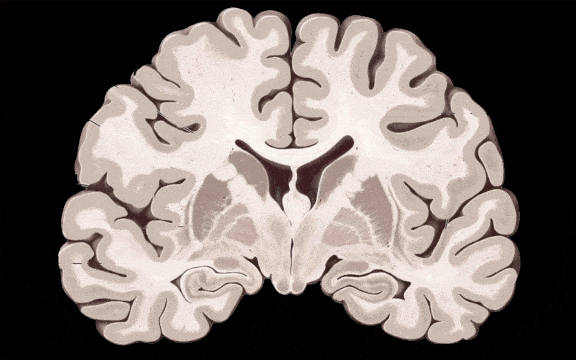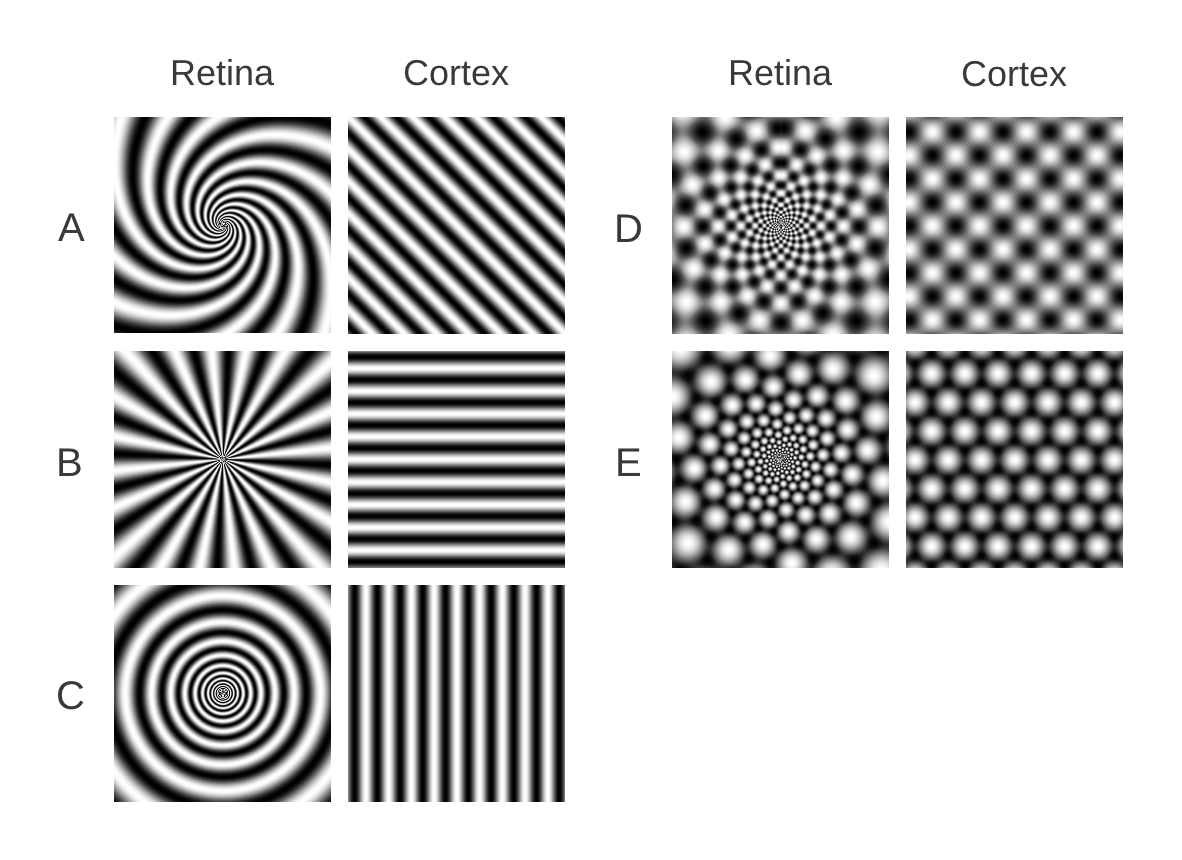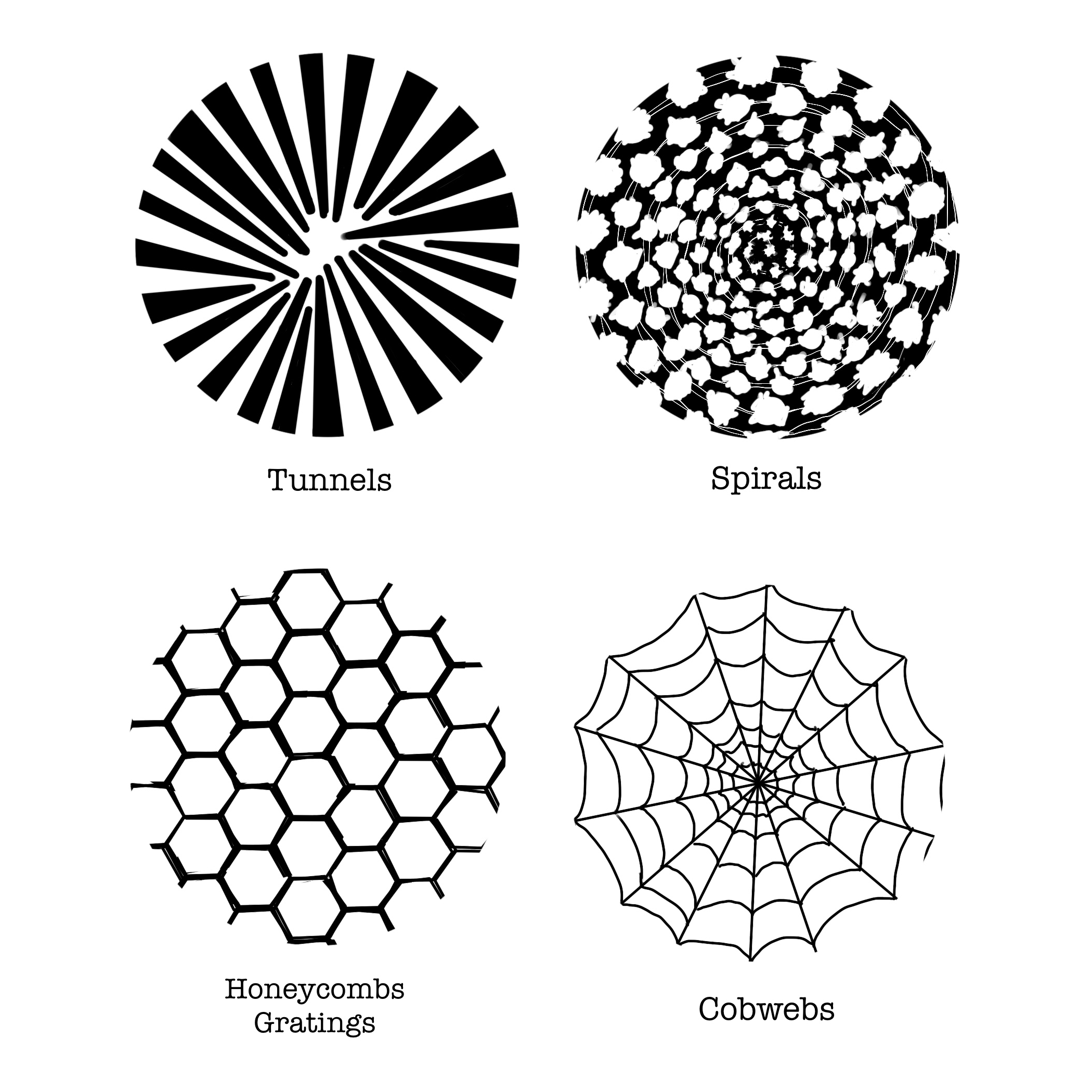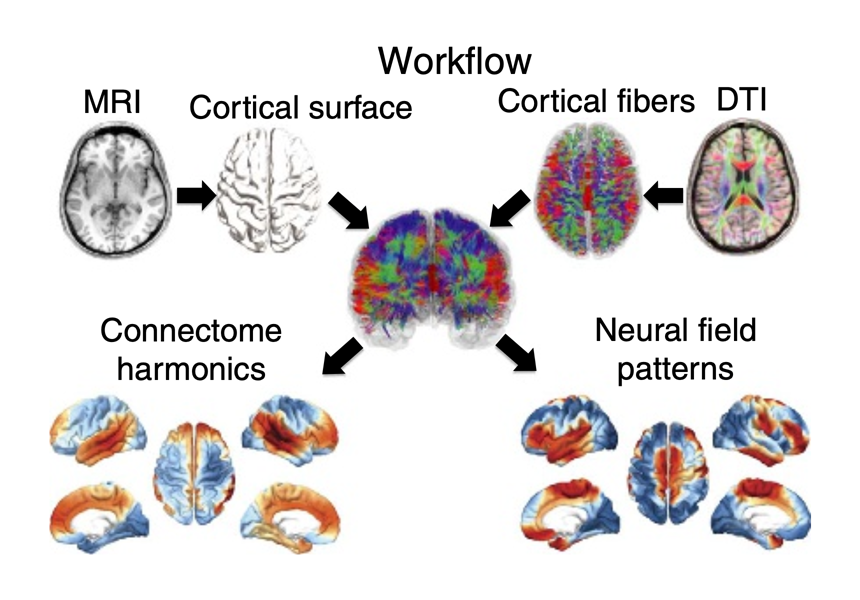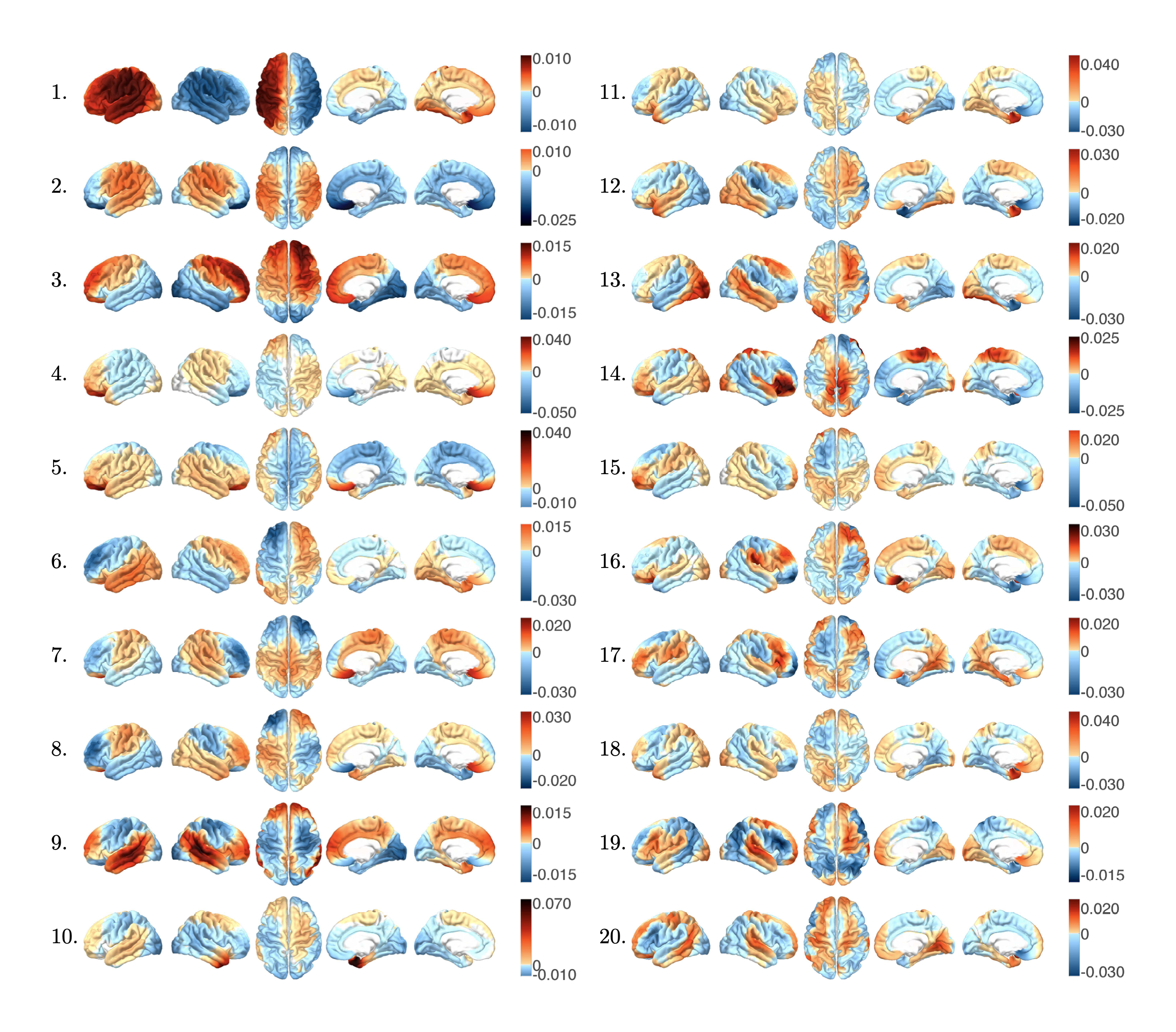An introduction to Steven Lehar, part II: Symmetries and periodicities
Posted on 22 November 2022 by
Previously on smoothbrains.net, we explored Steven Lehar’s bubble world model of phenomenology, mostly taking it at face value. At the time, we didn’t really discuss the experiences which inform his work. This is what we are doing now.
I ended that post with:
In the next post in this series, we’ll take a look at his autobiography, The Grand Illusion – in which Lehar answers the question: what happens when a vision researcher takes acid?
I consider it worth reiterating that Lehar is not just a vision researcher – he is also a rational psychonaut, seeking to derive scientific insight from psychedelic experiences without being misled by their semantic content.
This is a common pitfall, which he dodges in a way you might expect of a man of science. In his own words:
A curious phenomenon reported in the drug literature is a recurring reference to encounters with alien intelligences. A great number of different people have reported this phenomenon under the effect of a variety of dissociative drugs, including John Lilly, the Grand Master of ketamine promotion. The creatures are often reported to be friendly, intelligent, and inquisitive, seen as if through a portal that leads to another universe where they live. Some report that the aliens invite them to come over into their world. Some report that the aliens are malicious, and that they inhabit the “real” universe, and spend their efforts perversely creating the false hallucination of your world of experience. Some report the appearance of elves, which they can describe with great specificity.
What is the origin of these alien intelligences, I wondered, and why is it that different people have reported the same thing? It seemed just a bit too coincidental to say that these are just hallucinations, even though in one sense that is exactly what they are. If you fall victim to the Grand Illusion, you may suppose, as John Lilly insisted, that these are actual telepathic communications with alien entities from a distant galaxy. And that is exactly what they seem to be, if you take the experience at face value. But that explanation is far too bizarre for a hard-nosed scientific realist such as myself, and I sought to find an alternative explanation more consistent with scientific reality.
Having cleared the arena of such paranormal triflings, he is free to thoroughly investigate the phenomenology of altered states of consciousness, eventually developing an alternative model of neuroscience informed by his observations. We’ll take a look at this theory – which he calls harmonic resonance theory – which attempts to explain the macroscale organisational structures in the brain by relating them to their subjective phenomenology.
I wish to acknowledge that this is an unconventional approach. It’s like neuroscience from the inside out. Suffice it to say that science doesn’t normally work like this.
We’ll also look into a more recent development which complements this theory – connectome-specific harmonic wave theory, as pioneered by the neuroscientist Selen Atasoy – which also attempts to find the principles underlying macroscale neuronal organisation, but from an objective rather than subjective approach.
The Grand Illusion: A Psychonautical Odyssey Into the Depths of Human Experience
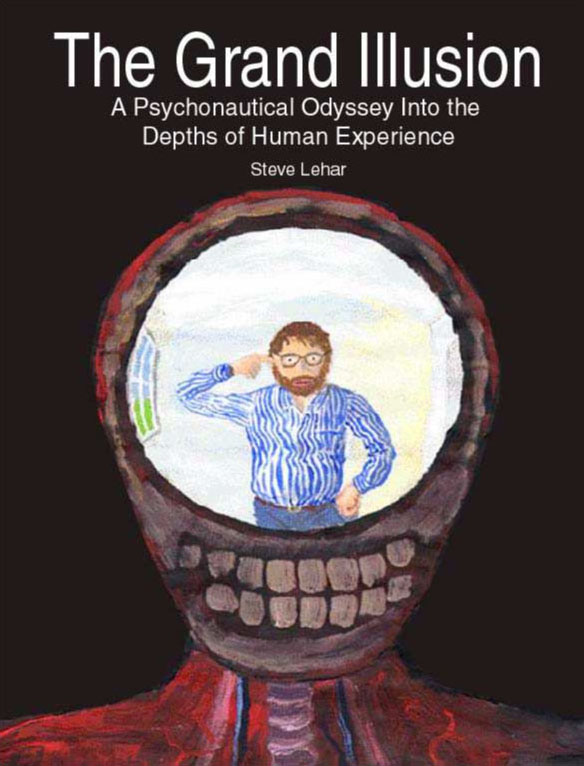
This book tells the story of my psychonautical exploits, from my early teen experimentation with alcohol intoxication, all the way to my most intense and dissociated experiences as a middle-aged adult, on a range of the most potent psychedelic and dissociative substances.
The Grand Illusion (2010) is something of a drug experience autobiography, with candidly written reports of the subjective effects of LSD, ketamine and many other substances. Lehar was working as a computer programmer and image analyst when, informed by his teenage LSD experiences, he decided to return to university to research the human visual system.
At some level, perhaps due in part to my adolescent experiences with LSD, I knew that the world of experience is a distorted picture of the actual world, although I had not yet pursued the implications of that idea to their logical conclusions. But one thing I did know was that I remembered my LSD experiences from many years ago, and I knew for a fact that the psychedelic experience would certainly offer powerful clues to the secret of biological vision. When I joined the PhD program therefore, I made a concerted effort for the first time in years to locate some LSD, and to consume it specifically for psychonautical purposes, i.e. as a tool for exploring the mechanism of conscious experience.
He tests the waters by dropping acid a handful of times, first wandering around Boston and then while hiking in the Austrian alps, before inviting his fellow graduate students up to his parents’ ski lodge by Cannon Mountain for some collective experimentation.
While I was a PhD student at Boston University, my parents owned a beautiful ski lodge house in the picturesque town of Mittersill in the mountains of New Hampshire, and on spring breaks or long weekends I would invite my friends, the other PhD candidates, up to Mittersill where we would take long hikes up the mountain, and spend evenings by the fireplace. I introduced a small circle of my friends to the illuminating experience of LSD, in the hopes of sharing some of my perceptual discoveries with them, and perhaps inducing them to learn to use the experience to make discoveries of their own. Eventually Mittersill became associated in our minds with these group trips with an ever-shrinking circle of true diehard psychonauts, making our regular pilgrimage up the mountain in search of Truth and to touch the face of God.
We were all adept computer programmers and well versed in mathematics as part of our PhD studies, so we all understood the issues of mental computation and representation, and I found the conversations about the computational principles of the mind, to be most interesting and intellectually stimulating. This was the high point of my academic career, this is why people want to be scientists.

What an ideal research setting. This was a productive time for Lehar. His reports on the effects of LSD are rich and detailed, with too many original observations to cover here – even the parts about mixing LSD with ketamine, which he terms free-wheeling hallucination. I will highlight one core insight, which touches on something very close to Mike Johnson’s Symmetry Theory of Valence:
I noticed that under LSD things appear a little more regular and geometrical than they otherwise do. It is not the shape of things that is different under LSD, but rather the shape of the things we see in objects. For example a cloud is about as irregular and fragmented a shape as a shape can be, and yet we tend to see clouds in a simplified cartoon manner, as a little puff composed of simple convex curves. A real cloud under closer inspection reveals a ragged ugly appearance with very indefinite boundaries and irregular structure. Under LSD the cloud becomes even more regular than usual. I began to see parts of the cloud as regular geometrical shapes, seeing the shapes in the shapes of the cloud as if on a transparent overlay.
And suddenly I could see it. This is the way the visual system encodes visual form in a compact or compressed manner, by expressing shape in terms of the next nearest regular geometrical form, or combination of forms.
I began to realize that the human mind is one great symmetry engine, that the mind makes sense of the world it sees by way of the symmetries that it finds in it. Symmetry is the glue that binds the fragments of experience into coherent wholes.
He later describes this visual simplification effect as like a Fourier representation with the higher harmonics chopped off. Indeed, it is as if one was to discard the high frequency, entropic components of one’s visuospatial representation, keeping only the simpler, more harmonious components. The visual field then fills in the gaps all the way up to the highest resolution sustainable – and by studying the resulting artifacts, we can gain insight into the system’s workings.
As I like to say, one way of understanding a system is by its failure modes. It’s a bit like if you tried to reverse engineer the JPEG format by taking an image and dialing up the compression – with an attentive eye on the distinctive blocky artifacts, a mathematically enlightened observer could perhaps figure out that the underlying representation uses a discrete cosine transform on an eight-by-eight pixel grid.
Then one day after agonizing for months on this issue, my LSD observations of periodic and symmetrical patterns suddenly triggered a novel inspiration. Maybe the nervous system does not require specialized hard-wired receptive fields to accomodate every type of vertex, replicated at every orientation at every spatial location. Maybe the nervous system uses something much more dynamic and adaptive and flexible. Maybe it uses circular standing waves to represent different vertex types, where the standing wave can bend and warp to match the visual input, and standing waves would explain all that symmetry and periodicity so clearly evident in the LSD experience as little rotational standing waves that emerge spontaneously at image vertices, and adapt to the configuration of those vertices.
Thanks to illegal psychotropic substances, I had stumbled on a staggeringly significant new theory of the brain, a theory which, if proven right, would turn the world of neuroscience on its head! My heart raced and pounded at the implications of what I had discovered. And this theory became the prime focus of my PhD thesis, in which I did computer simulations of my harmonic resonance model that replicated certain visual illusions in a way that no other model could. I had accomplished the impossible. I had found an actual practical use and purpose for what was becoming my favorite pastime, psychedelic drugs! It was a moment of glory for an intrepid psychonaut, a turning point in my life.
To be clear, when Lehar talks about resonance and standing waves here, he is talking about oscillatory processes in the electromagnetic fields that pervade our neural tissue. The neuronal membrane is not an electrical insulator – neuronal activation generates local field potentials which extend beyond the cell wall. These field potentials may then influence their neighbours, perhaps oscillating in synchrony with one another – and the whole field’s evolution in time would then influence neuronal activation in return. This is known as ephaptic coupling.
The leap of faith we may yet then take is that this field system also represents the structure of our experience via some unknown isomorphism – that our worldsim, our model of volumetric experience is embedded in there somehow. The field is not an epiphenomenon; it is the one and same as our subjective phenomenal experience, and it performs some useful computational role by virtue of its dynamics.
Electromagnetic theories of consciousness are not unheard of these days – Electromagnetism’s Bridge Across the Explanatory Gap (Hales & Ericson, 2022) is one paper that I found compelling. Page two of the supplementary materials has a great diagram illustrating the membrane-scale electromagnetic fields.
Regardless of whether we are talking about patterns of neural activation or the electromagnetic fields that surround them, what Lehar realised is that it makes sense to model this system as a resonant one. Such a system’s state at a given time could be considered to be the weighted sum of a series of resonant modes, all the way from low frequency, macroscale oscillations responsible for synchronising disparate brain regions – to extremely high frequency, microscale oscillations representing the most fine-grained, entropic aspects of a world simulation.
This would be a self-tuning resonant system – whose resonances are being tuned in real time to represent and match incoming sensory data.
Once we allow for these assumptions, we can start to understand the brain as an analog, field-based computer that works to match incoming sensory information with a parsimonious interpretation. It attempts to select from an infinite set of possible interpretations of the world, and reifies the interpretation with the greatest possible symmetry. This is done in order to stabilise an efficiently interpretable model of the world from a wide array of noisy sensory inputs – and also because symmetry in such an oscillatory system is energetically efficient.
Normally this reification process is kept calibrated within a sensible range so as to ensure that one’s model of the world does not become overgeneralised relative to the external world. Out of necessity, our brains do in fact support entropic, non-symmetric information in their states, but those are costly to maintain. It would seem that under the influence of psychedelic drugs, the higher frequency resonant modes corresponding to this entropic information can become harder and harder to sustain. They would be chopped off, as Lehar described earlier. This would appear to the subject as an amplification of any symmetries and periodicities in their visual experience.
Lehar gives optical illusions as an example of these dynamics at work. He realised that resonance and standing waves in a field medium could explain phenomena such as boundary completion – in ways that the prevailing neural network models of the time could not.

This is what he wrote his PhD thesis about. He then sought to formalise and publish the general underlying principle, naming it harmonic resonance theory: a holistic model of neural computation that stands as an alternative to the neuron doctrine – the key insight being that brains can be better understood in terms of their resonant modes than their individual neurons.
Lehar’s intuitionistic way of seeing the world may well resonate with his fellow phenomenologists, myself included – but he ran into trouble at peer review time. Experiencing a series of rejections, he became understandably disillusioned with academia.
Well this turn of events left me in a rather strange state “career-wise”, if you could call my rather aimless rambling path through life a career path at all. I had given up a rather promising career in computer image processing and artificial vision to get a PhD in Cognitive and Neural Systems, because I had become interested in how nature solves the vision problem. I was convinced that nature harbored some mysterious and elegant trick for making animals see, because we see such amazing visual performance from some of the simplest of creatures.
So at this point in my life I took a few years off to write my book and publish some papers on my theories.
Fair call, Steven. As an independent researcher, he went on to combine harmonic resonance theory with gestalt theory to create harmonic gestalt theory, as detailed in the video below.
Gestalt theory has always posed a profound challenge for neuroscience, with its peculiar properties – emergence, reification, multistability and invariance – in which the principle appears to be that the interaction between innumerable local forces, simultaneously and in parallel, produce a global gestalt reifying the most regular interpretation and thereby suppressing its alternatives, or becoming multistable between them. Harmonic resonance exhibits exactly those properties!
We’ll cover visual reification in greater detail in the next post in this series, An introduction to Steven Lehar, part III: Flame fronts and shock scaffolds, when we read The Constructive Aspect of Visual Perception. In the meantime, I’d like to wrap up with a simple experiment which might demonstrate the subjective effects of harmonic resonance in the brain.
Flicker phosphenes
When people stare into strobe lights, they often report seeing curious geometric patterns. One possible explanation is that the rapid stimulus causes standing waves to form across the surface of the visual cortex – and as the retinotopy between the retina and the visual cortex undergoes a log-polar transform, these standing waves may manifest as tunnel-like patterns in the subject’s experience. Vertical standing waves will be rendered as starburst shapes, and horizontal ones as concentric circles.
These patterns are known as flicker phosphenes, as studied by Dr. Michael E. Rule. They are also known as ganzflicker. They closely resemble the form constant patterns commonly observed on psychedelics, perhaps suggesting that a similar resonance phenomenon is happening during those states.
This phenomenon is best explored with a continuously adjustable strobe light, allowing the subject to “dial in” to the resonant frequencies that generate the most interesting patterns. These frequencies typically fall in the range of 8 to 25 Hz.
I have written a quick and dirty JavaScript strobe application with which you could test this out for yourself. This should not be used if you have epilepsy or are prone to seizures. Please be careful.
10.0 Hz
What do you see? If I set the strobe to about 11.5 Hz, I can see a kind of eight-pointed starburst filling in a square portion of my worldsheet. But we can’t expect everybody’s visual cortex to resonate in the same way, so at that frequency you may see something completely different! If something interesting happens and you can describe or illustrate your experience – or even if it doesn’t work for you – I’d love to hear from you on Twitter.
Connectome-specific harmonic wave theory
For additional conceptual support, I’d like to provide a summary of Selen Atasoy’s work on connectome-specific harmonic wave theory. For a far more comprehensive writeup, I recommend Mike Johnson’s post, A Future for Neuroscience.
I will provide a brief review of two of her papers:
- Human brain networks function in connectome-specific harmonic waves (Atasoy et al., 2016)
- Functional harmonics reveal multi-dimensional basis functions underlying cortical organization (Glomb et al., 2021)
Atasoy’s team starts by creating a graph representation of ten human connectomes, using MRI data for the grey matter and DTI data for the white matter:
This is not a detailed scan down to the cellular level; that would be beyond our current capabilities. This is a volumetric scan that is then filled artificially with uniformly sampled data points representing nodes on the connectome graph – which is sufficient for this mode of analysis.
Once you have a graph representation of a mechanical system, it is possible to calculate its eigenmodes using something called the graph Laplacian. This is a method that can be used to calculate the oscillatory modes of mechanical objects – like the ubiqitous Chladni plates.
In the literature, Laplace eigenvalue–eigenvector pairs (eigenmodes) have received significant attention initially due to their relation to the excitation spectrum of a given geometry: the eigenvalues relate to the natural frequencies, the allowed frequencies of standing waves emerging on that particular geometry, whereas the eigenvectors yield the associated wave patterns.
In this case, they run this process on simulated human connectomes to calculate their associated connectome harmonics. Here you can see the first twenty harmonics for one subject, in ascending frequency:
Next, they took seven reference resting state networks – commonly observed patterns of activation on fMRI; including the default mode network, which is said to correspond to the ego or sense of self – and attempted to correlate them with the set of functional harmonics.
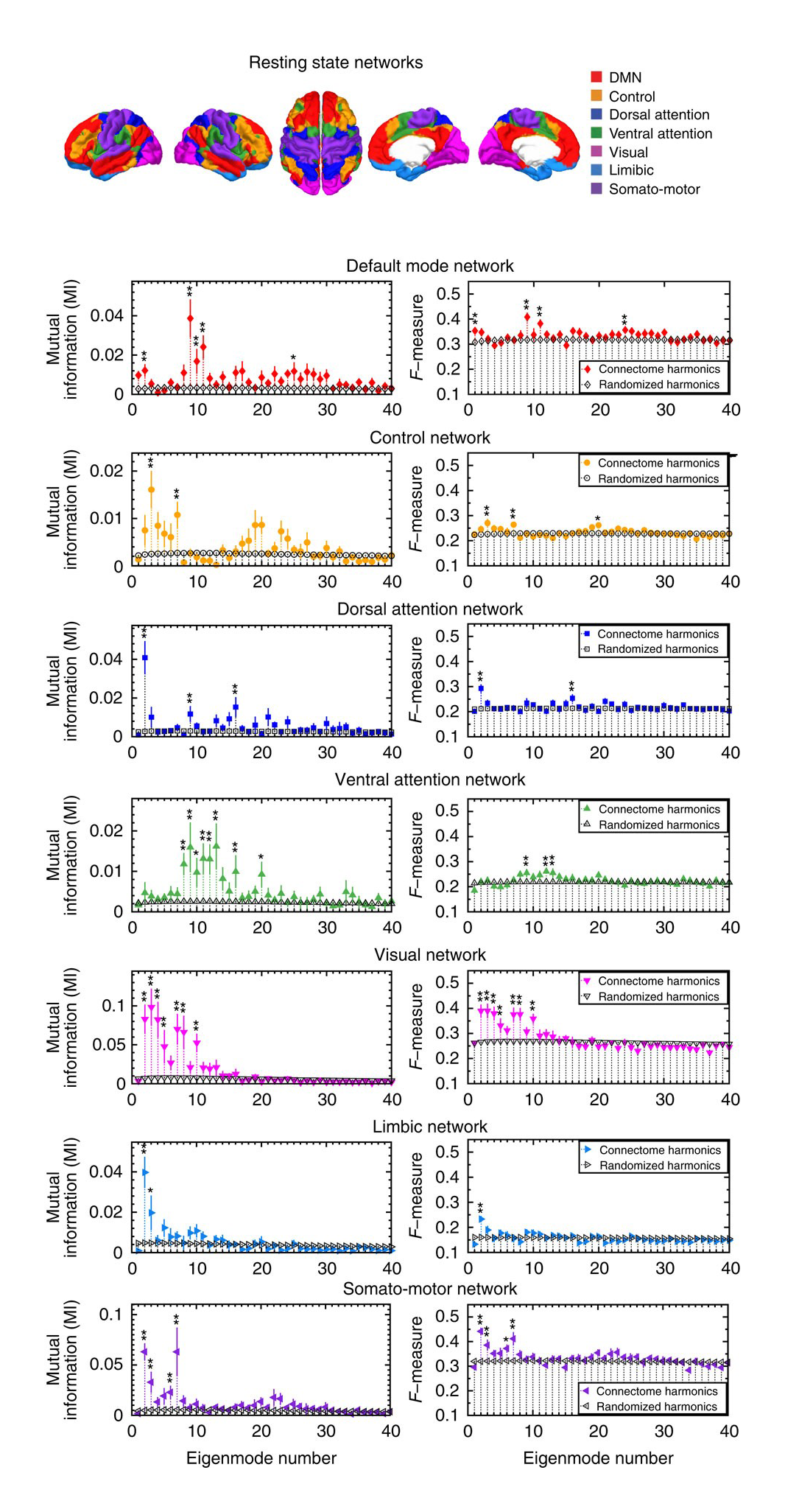
Remarkably, decomposition of the RSNs into the connectome harmonics revealed significant overlap between the resting state networks and certain connectome harmonic patterns. This suggests that connectome harmonics provide a simple explanatory principle linking the dynamics of oscillatory cortical networks to the anatomy of the human connectome.
This finding is the first experimental evidence demonstrating that the ubiquitous mathematical framework, eigendecomposition of the Laplacian, when applied to the human connectome, can provide a simple yet almost universal principle possibly underlying the functional networks of the brain.
If you take a look at that chart, you can see the statistically significant similarity between the 9th connectome harmonic and the default mode network. However, the statistical similarities were less prominent for the other resting state networks.
They scaled up their study for the 2021 paper, using 812 fMRI images from the Human Connectome Project to yield much more detailed results:
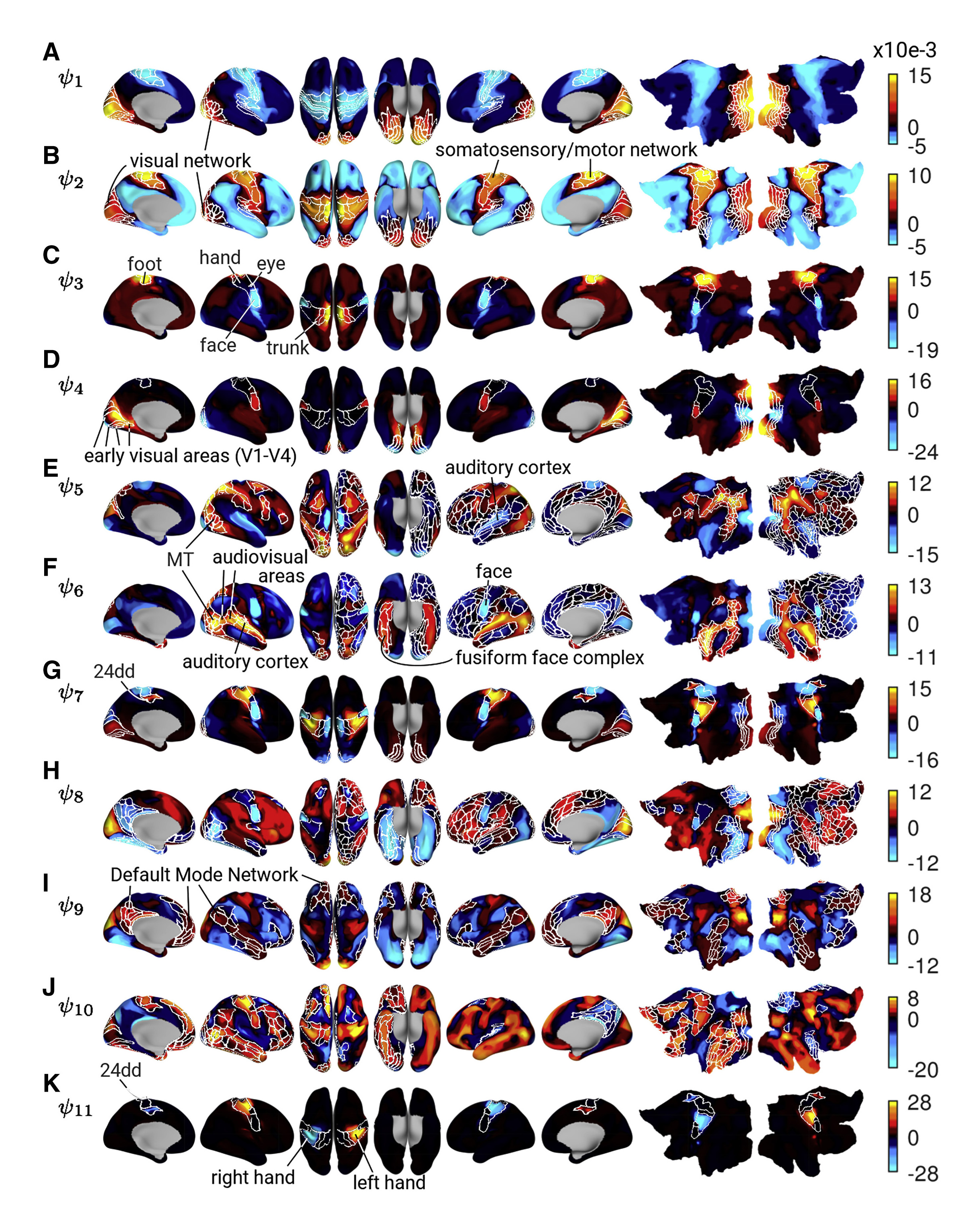
The first 11 non-constant functional harmonics plotted on the cortical surface. It is clearly visible that the first two functional harmonics (A and B) constitute global gradients over the entire cortex, whereas subsequent maps (C-K) include increasingly more local details. In each functional harmonic, known functional regions (e.g., C), processing streams (e.g., E) or networks (e.g., B) are discernible, and we have annotated the most conspicuous ones.
In order to illustrate that similarly colored patches of cortex correspond to known functional regions, borders of HCP parcels have been added (white lines). V1-V4, visual areas 1 to 4; MT, middle temporal visual area; 24dd, an area that contains a higher order representation of the hand; fusiform face complex, an area that responds specifically to images of human faces. The functional harmonics were derived from the HCP’s dense functional connectivity matrix, which is an average of over 812 subjects.
This is a compelling figure. The patterns of activation are visible and clearly correspond to the established functional regions. I can’t help but speculate – what might happen if we attempted to detect, then stimulate or suppress these harmonics directly? We know that transcranial magnetic stimulation can induce remarkable subjective effects, as per Susan Blackmore’s account from Michael Persinger’s laboratory:
It felt for all the world as though two hands had grabbed my shoulders and yanked me upright… I felt as though I had been stretched halfway up to the ceiling. Then came the emotions. Totally out of the blue, but intensely and vividly, I suddenly felt angry. Later… I was terrified.
Perhaps targeting connectome harmonics would provide a more direct, less exploratory approach, that taps directly into the brain’s macroscale organisational dynamics? If it is the case that the 9th functional harmonic correlates with the default mode network – perhaps dampening it could induce ego death without the hassle of taking psychedelics?
The jhānas are a set of highly pleasurable states of consciousness observed in Theravāda Buddhism, which can be accessed through deep concentration meditation. Part of what characterises the jhāna states is full-body pīti – a sense of pleasant vibrations on the surface of the skin.
I would speculate that pīti corresponds with some kind of standing wave phenomenon, either encompassing or overlapping the somatosensory cortex, where the somatosensory body map is located. The 3rd, 7th and 11th connectome harmonics correlate with various parts of the somatosensory/motor system; perhaps stimulating some combination of these could assist one in entering the first jhāna? At the very least, the 11th harmonic corresponds to the hand areas – perhaps stimulating that would give you super-saiyan pīti hands?
The jhāna state can be spotted by eye on EEG recordings, and there is already one company building a biofeedback device for jhāna practice. Obvious concerns about wireheading aside, it’s not hard to imagine some kind of near-future qualiatech which combines TMS with EEG, to sculpt one’s brain state to one’s heart’s content – but I do find it difficult to imagine this future without something like connectome-specific harmonic wave theory.
